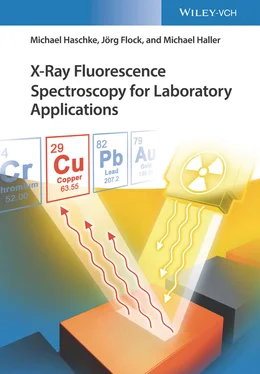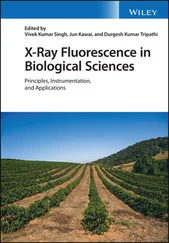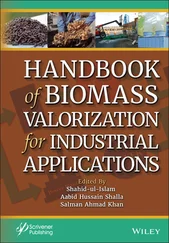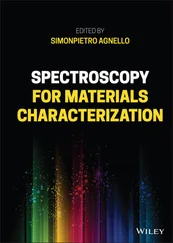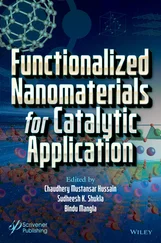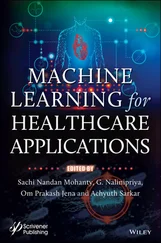1 Cover
2 Title Page X-ray Fluorescence Spectroscopy for Laboratory Applications Michael Haschke Jörg Flock Michael Haller
3 Copyright Authors Dr. Michael Haschke Günter Allee 11 15345 Eggersdorf Germany Dr. Jörg Flock Thyssen Krupp Stahl AG Kaiser-Wilhelm-Str. 100 47166 Duisburg Germany Dipl.-Min. Michael Haller CrossRoads Scientific LLC. Middletown CT United States All books published by Wiley-VCH are carefully produced. Nevertheless, authors, editors, and publisher do not warrant the information contained in these books, including this book, to be free of errors. Readers are advised to keep in mind that statements, data, illustrations, procedural details or other items may inadvertently be inaccurate. Library of Congress Card No.: applied for British Library Cataloguing-in-Publication Data A catalogue record for this book is available from the British Library. Bibliographic information published by the Deutsche Nationalbibliothek The Deutsche Nationalbibliothek lists this publication in the Deutsche Nationalbibliografie; detailed bibliographic data are available on the Internet at < http://dnb.d-nb.de >. © 2021 Wiley-VCH GmbH, Boschstr. 12, 69469 Weinheim, Germany All rights reserved (including those of translation into other languages). No part of this book may be reproduced in any form – by photoprinting, microfilm, or any other means – nor transmitted or translated into a machine language without written permission from the publishers. Registered names, trademarks, etc. used in this book, even when not specifically marked as such, are not to be considered unprotected by law. Print ISBN: 978-3-527-34463-5 ePDF ISBN: 978-3-527-81660-6 ePub ISBN: 978-3-527-81662-0 oBook ISBN: 978-3-527-81663-7 Cover Design Formgeber, Mannheim, Germany
4 Preface
5 List of Abbreviations and Symbols
6 About the Authors
7 1 Introduction
8 2 Principles of X-ray Spectrometry2.1 Analytical Performance 2.2 X-ray Radiation and Their Interaction 2.3 The Development of X-ray Spectrometry 2.4 Carrying Out an Analysis
9 3 Sample Preparation3.1 Objectives of Sample Preparation 3.2 Preparation Techniques 3.3 Preparation of Compact and Homogeneous Materials 3.4 Small Parts Materials 3.5 Liquid Samples 3.6 Biological Materials 3.7 Small Particles, Dust, and Aerosols
10 4 XRF Instrument Types4.1 General Design of an X-ray Spectrometer 4.2 Comparison of Wavelength- and Energy-Dispersive X-Ray Spectrometers 4.3 Type of Instruments 4.4 Commercially Available Instrument Types
11 5 Measurement and Evaluation of X-ray Spectra5.1 Information Content of the Spectra 5.2 Procedural Steps to Execute a Measurement 5.3 Selecting the Measurement Conditions 5.4 Determination of Peak Intensity 5.5 Quantification Models 5.6 Characterization of Layered Materials 5.7 Chemometric Methods for Material Characterization 5.8 Creation of an Application
12 6 Analytical Errors 6.1 General Considerations 6.2 Types of Errors 6.3 Accounting for Systematic Errors 6.4 Recording of Error Information
13 7 Other Element Analytical Methods7.1 Overview 7.2 Atomic Absorption Spectrometry (AAS) 7.3 Optical Emission Spectrometry 7.4 Mass Spectrometry (MS) 7.5 X-Ray Spectrometry by Particle Excitation (SEM-EDS, PIXE) 7.6 Comparison of Methods
14 8 Radiation Protection8.1 Basic Principles 8.2 Effects of Ionizing Radiation on Human Tissue 8.3 Natural Radiation Exposure 8.4 Radiation Protection Regulations
15 9 Analysis of Homogeneous Solid Samples 9.1 Iron Alloys 9.2 Ni–Fe–Co Alloys 9.3 Copper Alloys 9.4 Aluminum Alloys 9.5 Special Metals 9.6 Precious Metals 9.7 Glass Material 9.8 Polymers 9.9 Abrasion Analysis
16 10 Analysis of Powder Samples 10.1 Geological Samples 10.2 Ores 10.3 Soils and Sewage Sludges 10.4 Quartz Sand 10.5 Cement 10.6 Coal and Coke 10.7 Ferroalloys 10.8 Slags 10.9 Ceramics and Refractory Materials 10.10 Dusts 10.11 Food 10.12 Pharmaceuticals 10.13 Secondary Fuels
17 11 Analysis of Liquids 11.1 Multielement Analysis of Liquids 11.2 Fuels and Oils 11.3 Trace Analysis in Liquids 11.4 Special Preparation Techniques for Liquid Samples
18 12 Trace Analysis Using Total Reflection X-Ray Fluorescence12.1 Special Features of TXRF 12.2 Sample Preparation for TXRF 12.3 Evaluation of the Spectra 12.4 Typical Applications of the TXRF
19 13 Nonhomogeneous Samples 13.1 Measurement Modes 13.2 Instrument Requirements 13.3 Data Evaluation
20 14 Coating Analysis14.1 Analytical Task 14.2 Sample Handling 14.3 Measurement Technology 14.4 The Analysis Examples of Coated Samples
21 15 Spot Analyses 15.1 Particle Analyses 15.2 Identification of Inclusions 15.3 Material Identification with Handheld Instruments 15.4 Determination of Toxic Elements in Consumer Products: RoHS Monitoring 15.5 Toxic Elements in Toys: Toys Standard
22 16 Analysis of Element Distributions16.1 General Remarks 16.2 Measurement Conditions 16.3 Geology 16.4 Electronics 16.5 Archeometric Investigations 16.6 Homogeneity Tests
23 17 Special Applications of the XRF17.1 High-Throughput Screening and Combinatorial Analysis 17.2 Chemometric Spectral Evaluation 17.3 High-Resolution Spectroscopy for Speciation Analysis
24 18 Process Control and Automation18.1 General Objectives 18.2 Off-Line and At-Line Analysis 18.3 In-Line and On-Line Analysis
25 19 Quality Management and Validation19.1 Motivation 19.2 Validation
26 Appendix A: Tables
27 Appendix B: Important InformationB.1 Coordinates of Main Manufacturers of Instruments and Preparation Tools B.2 Main Suppliers of Standard Materials B.3 Important Websites B.4 Laws and Acts, Which Are Important for X-Ray Fluorescence
28 References
29 Index
30 End User License Agreement
1 Chapter 2 Table 2.1 Approximate relative line intensities of main X-ray lines. Table 2.2 Comparison of line designations for the main X-ray lines.
2 Chapter 3 Table 3.1 Preparation technologies for solid samples. Table 3.2 Information depth for different fluorescence lines in various mater... Table 3.3 Information depth and accumulated intensity in the case of 10 wt% N... Table 3.4 Estimations of the sample volume and mass that contribute to the me... Table 3.5 Contaminations in the range of traces by preparation tools (main co... Table 3.6 Steps for processing and sampling of small part materials. Table 3.7 Mills for fine grinding of powder-like material. Table 3.8 Binders and additives for pressed pellets. Table 3.9 Flux agents for different applications. Table 3.10 Sample–flux ratios for typical materials in grams (valid for diame... Table 3.11 Window materials for sample cups for liquid samples.
3 Chapter 4 Table 4.1 Comparison of wavelength- and energy-dispersive X-ray spectrometer ... Table 4.2 Often used crystals for wavelength-dispersive spectrometry.Table 4.3 Instrument setup parameters.Table 4.4 Products offered by instrument manufacturers for different instrume...
4 Chapter 5Table 5.1 Contributions to the Cr intensity by primary, secondary, and tertia...Table 5.2 Relative statistical error as a function of the number of counts.Table 5.3 Substances suitable for standard addition.Table 5.4 Analytical uncertainties for different sample qualities, measuring ...Table 5.5 Settings for the preparation of an analytical method.
5 Chapter 6Table 6.1 Results of repeated intensity measurements.Table 6.2 Student's t -distribution in dependence of the probability p and the ...Table 6.3 Addition of error contributions.Table 6.4 Number of significant figures typical for X-ray fluorescence.
6 Chapter 7Table 7.1 Comparison of methods for element analyses.
7 Chapter 8Table 8.1 Relative sensitivities of different body parts.Table 8.2 Radiation levels depending on dose.
Читать дальше
